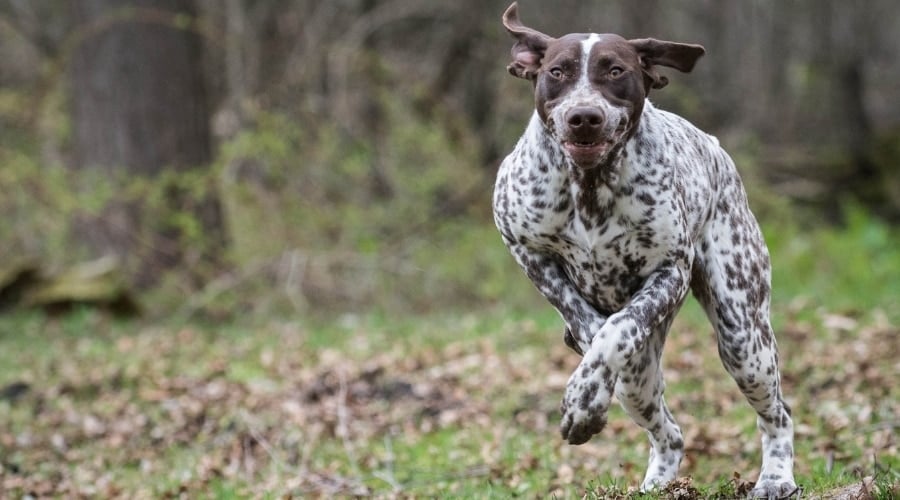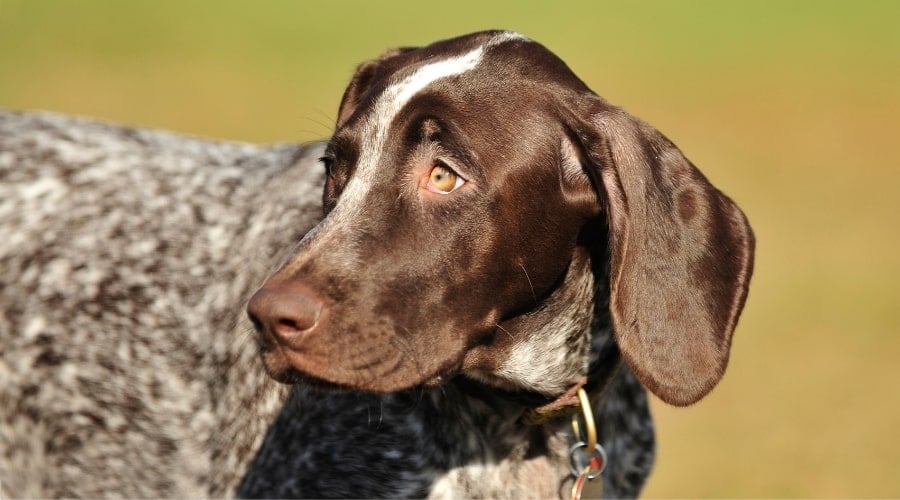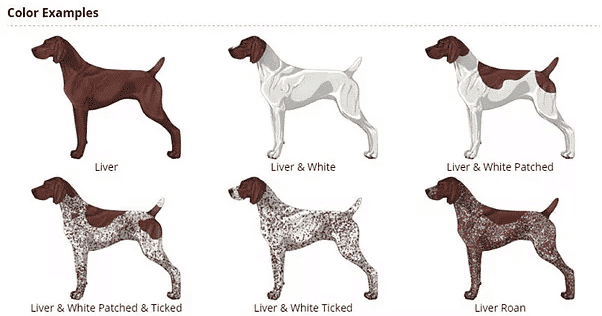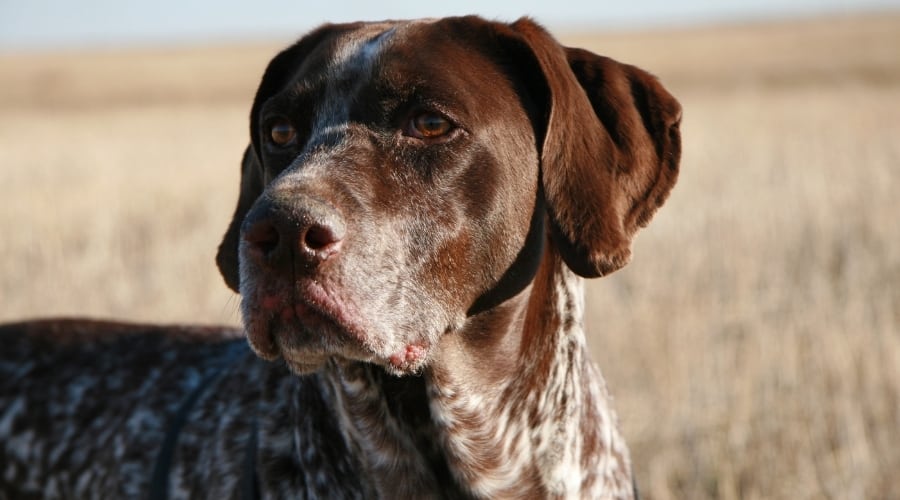German Shorthaired Pointer Breed Information: Facts, Traits, Pictures & More
When you purchase through links on our site, we may earn a commission. Here’s how it works.
The German Shorthaired Pointer is one of the least well-known but fairly popular dogs. He has steadily risen in the American Kennel Club popularity contest each year. This lesser-known breed makes a lovely companion for an active family, but it is there to know before bringing one home. Let me introduce you to the one and only German Shorthaired Pointer breed.
Table of Contents
Breed History

This popular breed originated in 17th-century Germany. German hunters desired a perfect hunting dog, so they mixed several dog breeds to create the breed that we all know and love today. The German Bird Dog, also known as the German Pointer and English and Spanish Pointers, was mixed with a little Bloodhound, and this breed was born.
German Shorthaired Pointers were bred to hunt in the day and night and collect all types of quarry with his strong scenting ability. They are sleek and powerful, pleasing to the eye, and a loving family companion. They first came to the US in 1925, and slowly but surely, he has become extremely popular with hunters and families alike. His cousin, the German Wirehaired Pointer, looks very similar, just with a shaggier coat. And the German Longhaired Pointer looks more Spaniel-like.
Temperament

The first and possibly most important thing to know is that the GSP breed is super energetic. He should only be taken on by an active family who can guarantee him between 60 and 90 minutes of intense exercise daily.
Lots of energy and curiosity means you can expect a breed that’s tons of fun. The GSP breed is ideal if you are looking for a canine sibling to entertain the kids. He will happily fetch and play all day long with whoever will give him the attention. He loves swimming, playing tug of war, and participating in agility courses. All-weekend hiking? No problem! Doggy athletic competitions? He’s got it covered.
Pointers are calm in the home, which makes them the ideal pet for family life. They are well-mannered, neither too boisterous nor sedentary. This breed enjoys relaxing in the house, knowing that you are relaxing somewhere nearby. They don’t like to be left alone for too long, so they are best placed with a family where someone can be home during the daytime. Separation anxiety can be an issue if not addressed early.
He is dutiful and very eager to please his family. This means that he will be an obedient canine companion with early training. This makes him a great option for first-time dog owners. You also need to know that he has a strong prey drive, and there is every chance he will bolt at the scent or sight of a squirrel.
Size & Appearance

Pointers are medium-to-large-sized dogs. They weigh between 45 and 70 pounds, with male dogs tending to be larger than their female counterparts. They measure between 21 and 25 inches tall, from paw to shoulder. They are well-proportioned, athletic, and muscular. Their short coat shows off their muscle-bound, powerful body.
The GSP’s muzzle and face are square but well-proportioned. He has a large fleshy nose; according to his breed standard, the bigger, the better. His eyes are almond-shaped and large. They often have a good-humored and intelligent expression. His ears are long and drop just below his jawline. The tail is always docked and sits straight, never curved or bent.
Coat & Colors

This breed has short hair that is surprisingly thick and water-repellant. When you stroke him, his coat is soft and sleek. He sheds lightly throughout the year and slightly heavier during the shedding seasons. This is one of his appeals: he is a clean dog who sheds minimally and requires little grooming.
He sports a variety of three main shades: black, liver, and white. Rarely will he be all black or all liver (reddish brown) in color. But mostly, he will sport a mixture of either black and white and liver and white. Some coats will be described as roan, a mixture of white and pigmented hairs that do not “gray out.” Patches of color are also common, with colored heads and speckled bodies being common.

According to The National German Shorthaired Pointer Rescue, a few rare black and white GSPs are not accepted as part of the AKC breed standards.
Exercise Needs

As you already know, these pups have high levels of energy and exercise requirements. It’s worth repeating again – if you don’t lead an active lifestyle, this is not the breed for you.
You must guarantee between 60 and 90 minutes of exercise every day. They love running and swimming and should have two rigorous exercise sessions daily.
If you cannot commit to this or regularly skip on his exercise needs, you and he will be very unhappy together. The GSP is only well-mannered if all of his needs are met. If they are not, he will become overly anxious and destructive. He is a traditional hunting dog who could happily spend all day in the field, so do not expect him to sit tight all day.
His intelligent and curious mind must also be stimulated throughout the day. He needs both interactive play and solo playtime, which is where doggy toys come in. All dogs are different and prefer different types of toys, but a mixture is ideal to suit whatever mood he is in. Chew toys, ropes, balls, and puzzle-solving treat-dispensing toys are all fantastic and will keep him out of trouble.
Living Requirements

Pointers are not suited to apartment living. They are country dogs that love the outdoors and fresh air. Being cooped up in an apartment all day, no matter how large, is not their ideal home. They need access to a yard, which needs to be secured because they will chase birds and squirrels. This breed is super agile and can climb pretty high, too, especially if he’s got a long run-up, so make sure your fences are high.
He is a well-mannered dog and not overly boisterous in the home, meaning that he is an ideal canine sibling for children. Always supervise dogs and children, but you can rely on this breed to play gently. If appropriately socialized, he will do well with other dogs in the home. But his high prey drive means he is not suited to living with other animals, including birds, rodents, and cats.
Training

The German Shorthaired Pointer is an intelligent and trainable dog. This makes him an ideal companion for first-time dog owners. But you will still need to put effort into his training because he needs to be shown the doggy ropes. Do not expect him to work it out alone.
The first part of his training that you need to consider is the socialization process. He needs to spend time with other dogs and humans from an early age to ensure that he grows into a well-mannered and polite dog. You also need to expose him to grooming and loud noises in and out of the home, which builds confidence. You can learn more about puppy socialization in this expert guide.
Positive reinforcement training is the best method to train this breed. But because he is a sensitive breed, he will not react well to stern or harsh training. You definitely don’t want a fearful hunting companion that’s likely to run away rather than recall.
It’s a great idea to crate-train this breed. Crate training is beneficial for all dogs, especially those who can become overly anxious when left alone. A crate provides a safe haven that he can call his own. And it can also keep him out of trouble when you have to leave him at home alone.
Recall will be the most challenging training task. Although Pointers will almost always come back, there’s a big chance that he will not if he has caught sight or the scent of a bird or squirrel. If you let him off-leash, you need to be certain that he will come back. Thankfully, the breed’s responsiveness is one of the reasons why he is commonly chosen as a hunting dog.
Health

The Pointer is a healthy dog breed. On average, the GSP enjoys a lifespan of 10 to 12 years. The best way to keep him healthy is to keep up to date with regular veterinary health checks and vaccines. Exercise and top-quality nutrition also go a long way to keeping him in tip-top condition and perhaps extending his life with you.
Like all purebred dogs, the GSP breed is more predisposed to certain health conditions than others. Below are the most commonly found health concerns in the breed. So, reading up on these conditions and recognizing their associated symptoms is a great idea.
- Hip & elbow dysplasia: Joint dysplasia in the hip and elbow joint is common in medium and large breeds. It occurs when the joints do not form as they should, which causes increased grinding. Over time, this leads to increased pain and will affect his mobility.
- Eye conditions: This is one of the few breeds that suffer from a condition known as cone degeneration. It is essentially day blindness; his vision in bright light is impaired but fine in normal conditions. It is inherited from his parents and can be identified through a DNA test. Cataracts are the most common cause of blindness in older dogs. Progressive retinal atrophy (PRA) is another eye health issue often affecting the breed.
- Cardiac concerns: Some dogs suffer from a condition known as aortic stenosis. This is caused by a partial blockage to the blood leaving his heart, making his heart work harder. Fainting during exercise is a sign to look out for.
- Cancer – The German Shorthaired Pointer breed club found that cancer is a common problem found in the breed. With mammary tumors, lymphosarcoma, and mast cell tumors being the most commonly reported.
- Bloat – Gastric dilation-volvulus, also called canine bloat and gastric torsion, can affect the GSP breed. This life-threatening condition occurs when dogs eat or drink too much too fast. The stomach can twist on itself and cut off circulation.
A GSP Pet Insurance Story
Pet insurance can help cover the cost of care in an emergency or for a serious medical issue. Our extensive guide details what pet insurance is and how it works. The story below illustrates how pet insurance can help better your pup’s life.
- Pet: Pete, a 3.5-year-old German Shorthaired Pointer
- Diagnosis: Severe nausea/vomiting from ingesting something toxic to him
- Treatment:
- Emergency room visit (outside of normal vet hours)
- X-ray
- Anti-nausea injections and prescription medication
- Subcutaneous fluid injection
- Claim Cost: $902.32
- Figo’s Reimbursement: $900.14
- Out Of Pocket: $2.18
Pete is a 3.5-year-old German Shorthaired Pointer who had what many GSP owners call “an extended puppyhood.” He has plenty of energy, is naturally curious, and is prone to getting into things that he shouldn’t.
Unfortunately, he also prefers to do his work well outside of our veterinarian’s normal business hours, which has resulted in multiple trips to the emergency vet nearby (once for eating ibuprofen, another time for eating a whole pack of chewing gum, and so on).
On one particular evening, we came home to find that Pete had gotten sick in a few places around the house, and we could tell that he really wasn’t feeling good. Worried that he might have eaten something that was causing a blockage, we drove to the emergency vet nearby to have them take a look.
The vet performed an x-ray and luckily saw no signs of a blockage but decided to give him some anti-nausea medicine and fluids since he had gotten sick. After a few days of medicine and a bland diet, he was full of energy and back to his normal self.
This visit to the vet turned out to be an expensive one at around $900, but we were very fortunate to have almost the entire thing covered by our policy. Pete seems to be calming down a little as he’s getting older, so hopefully our trips to the emergency vet are behind us. At least we know we’re covered if we find ourselves back there.

Nutrition

On average, Pointers will consume between two to three cups of food every day. This varies depending on age, size, and energy levels. Of course, working dogs might need more than this.
He needs a well-balanced diet with high-quality meat protein, carbohydrates, fiber, healthy fats, vitamins, and minerals. Dried kibble is a safe way to ensure he gets everything he needs and is safe and convenient for you. It will also help lower plaque buildup compared to wet foods. We advise feeding him a large breed formula, especially as a puppy. This is because they have increased glucosamine levels, which are ideal for an active lifestyle. Check out our guide for the best food for your German Shorthaired Pointer.
Due to the risk of bloat, you should never feed a GSP immediately before or after exercise. Smaller meals throughout the day are better to help reduce the risk.
Grooming

Pointers have short and sleek hair. They also have a relatively easy grooming schedule. And unlike other dogs, he isn’t considered a heavy shedder. Brushing him once a week with a bristle brush will help remove dead hairs and dirt and keep him looking smart. That said, you should still expect a little dog hair on your sofa and clothing. Learn more about the best de-shedding brushes to help control all that hair.
His weather and dirt-resistant coat is very clean, and dirt rarely sticks to him. This means that he only needs to be bathed once every three or four months, as and when he needs it. Do not wash him more than this. Otherwise, you will upset the balance of his natural coat oils, which help to keep him clean.
Don’t forget to bathe your dog with a gentle shampoo (like this Pro Pet Works Natural Oatmeal Dog Shampoo) occasionally, too. You should also inspect your dog’s ears once a week to remove the collection of gunk. He will also need weekly dental cleanings to keep periodontal diseases at bay. Always use doggy toothpaste, as human toothpaste is toxic to dogs. Nail clipping is also part of grooming,
The Pointer, with his short coat and exposed underbelly and legs, will regularly become scratched when out exercising. Running through foliage and bushes will scrape his belly. When you brush him, be sure to check the cuts to ensure that they do not become infected. A regular wipe-down after walks with warm water will minimize the risk of infections.
Breeders & Puppy Costs

The average price of a puppy from a reputable breeder will cost around $1,000 and up. If you are looking for an award-winning hunter or a show Pointer, you can expect to pay more than this. Rare all-black or all-liver colored Pointers might also be priced higher than their more commonly colored siblings. There are also other costs to factor into the puppy price, including setting up. Things such as crates, collars, harnesses, and dog toys all add up. And don’t forget pet insurance and veterinary costs.
Always do your research when looking for a top-quality breeder. Speak to other owners who might be able to refer you to their breeder, but still be sure to do your own research. Look for good reviews, and always meet them and their pups in person. A great place to start is the American Kennel Club’s list of reputable German Shorthaired Pointer breeders.
Rescues & Shelters

If you are thinking about rescuing a dog instead, why not head out to your local rescue shelter? Being one of the most popular dog breeds around, unfortunately, there are likely to be quite a few of them. The costs involved in rescuing a dog from a shelter are much less than buying a puppy from a breeder.
Many rescue organizations dedicate their efforts to one specific breed. Most of them can be found online. The National German Shorthaired Pointer Rescue lists rescue shelters state by state.
As Family Pets
German Shorthaired Pointers are highly active pups who make wonderful companions for families that spend a lot of time outside and on the move. They have a high prey drive, so they don’t do well with smaller animals, though they are great with kids. These pups hate being left alone and thrive on human attention. They are also quite friendly with strangers and other dogs.
If you have the energy to keep up with this breed, they can make a lovely, loyal companion. Just be sure you have a big yard with a solid fence and plenty of time to play. If you enjoy hunting, running, hiking, swimming, etc., this is an excellent breed for you. You may also want to get a fitness tracker for your dog to keep track of the distance he covers.
If you like spending your time indoors curled up on the couch with a good book in your hands and your loyal companion snuggled up on your lap, a Yorkshire Terrier or French Bulldog may be a better fit for you.
English Pointer vs German Shorthaired Pointer
English Pointers are a part of the German Shorthaired Pointer’s genetic makeup. Both breeds are hunting dogs; the English Pointer is used as a field dog for birds, while GSPs are more all-around hunters.
English Pointers are less popular than German Shorthaired Pointers. They stand slightly taller than GSPs but weigh roughly the same. They can live 12-17 years and require only a weekly brushing with occasional shedding.
English Pointers come in many colors, including:
- Black
- Black and white
- Lemon
- Lemon and white
- Liver
- Liver and white
- Orange
- Orange and white
Are You Ready To Adopt A New Dog?
The GSP will not let you down as a loyal, four-legged companion. However, before bringing any new pup home, you must be sure you are ready to care for a dog. If you have children at home, discussing their roles and expectations in helping care for your new fur baby is a good idea. Be sure to talk to all household members and ensure everyone is on board to help. We also cover common puppy mistakes to help you avoid setbacks when adjusting your pup to their new home.
Why Trust Canine Journal?
Emma is a dog owner with over 20 years of experience with canines. She has also worked as a professional dog walker and sitter for many years, caring for several dog breeds with different needs, including senior pups. Emma dedicates countless hours researching the latest pet care, health, food, and training developments to keep her two best buddies and other doggy clients as happy and healthy as possible.



